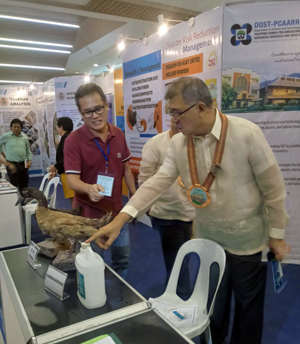
Bringing several of its research and development (R&D) outputs, the Philippine Council for Agriculture, Aquatic and Natural Resources Research and Development of the Department of Science and Technology (DOST-PCAARRD) joins this year’s celebration of the Central Visayas S&T Week held at the Island City Mall, in Tagiblaran City, Bohol on November 14-16, 2018.
DOST-PCAARRD aims to share with Boholanos the fruits of its R&D efforts. Through its exhibits and displays, the Council featured the technologies and information on coffee depulper, biological-based approaches for cacao pest management, enhancing mungbean productivity through carrageenan plant growth promoter, and Itik Pinas.
The village-level coffee depulper is an improved highly efficient prototype, which can depulp different varieties of coffee berries of varied sizes. It consists of two separate depulpers for smaller and bigger coffee berries.
Depulper 1 has a depulping efficiency of 96% for small coffee berries and 95% for medium coffee berries. Depulper 2 for large coffee berries has a depulping efficiency of 91.5%. On the average, the depulping system has a combined capacity of 302.3 kg/hour with pulp separation efficiency of 96% and depulping efficiency of 92%
The display on carrageenan highlights its positive effect on mungbean production. Carageenan is a product extracted from seaweeds, irradiated with a very small dose of gamma radiation, and acts as a plant growth promoter (PGP) when applied as foliar spray.
Foliar application of carrageenan PGP on mungbean can boost yield by more than 400% due to its bio-stimulant properties. The carrageenan PGP is an environment-friendly alternative to other kinds of fertilizers as it does not harm beneficial insects and can enhance crop resistance to pests.
The display on biological-based approaches for cacao pest management aims to promote research efforts to develop biological-based pest management program for the control of major insect pests and diseases of cacao such as the cacao pod borer (CPB), cacao mirid bug (CMB), cacao pod rot, and vascular streak disease.
Biological control is a very promising alternative to the more traditional use of chemical pesticides. It uses natural enemies or biological pathogens of pest species to bring down infestations to levels with minimal to no impact on productivity. It is also sustainable as it allows reproduction of the biological control agents when the host or prey (the pest) is present.
Itik Pinas (IP), on the other hand, highlights the three different strains – IP Itim and IP Khaki, which are both purelines, and IP Kayumanggi, which is a crossbreed of the two purelines. These strains are the first and only Philippine layer duck breeds developed through organized breeding and selection to address the industry problem of low and inconsistent egg production performance and product quality of the traditional mongrel ducks.
Among the benefits of IP are increased predictability in egg production performance with consistent product quality; increased average egg produced per duck per year from 201 eggs to 266 eggs; and stable supply and accessibility of breeder ducks and duck egg products.
The regional celebration of the S&T week is an event aimed at promoting the role and significance of S&T in regional and national development. It is participated in by national and regional offices and agencies of DOST.
